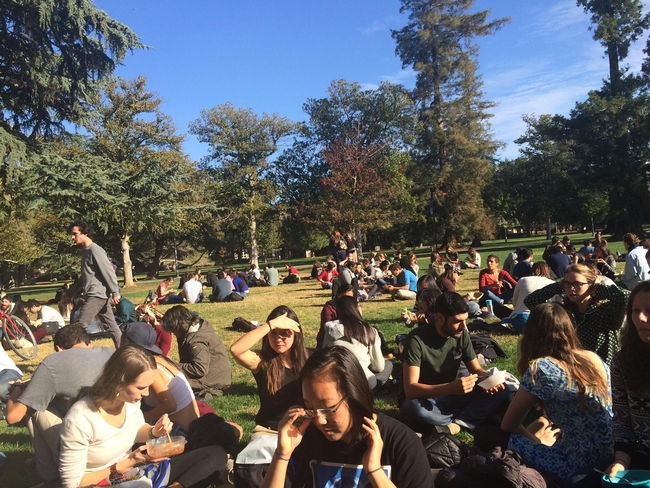Posts Tagged: food insecurity
UC students in 'protected environment' are vulnerable to food insecurity
Many people are surprised to learn that students enrolled in the state's premiere higher-education system are vulnerable to food insecurity, said Suzanna Martinez, a researcher with UC ANR's Nutrition Policy Institute, on the KPFA radio program Up Front. (Martinez's segment begins at the 20:23 mark.)
Martinez was interviewed for the program by host Pat Brooks, who was sitting in for Dennis Bernstein. Martinez said that anecdotal evidence of food insecurity on UC campuses was already popping up when UC President Janet Napolitano provided funding to each of the campuses to address the issue. The UC president also provided funding to the UC Nutrition Policy Institute to survey students across the system to document and understand food insecurity on UC campuses.
The report, issued last week, was based on the responses to a survey by about 9,000 students. Nineteen percent indicated they had “very low” food security and an additional 23 percent were characterized as having “low” food security. The greatest impact, Martinez said, was on the Latino and black student populations. Most of the students struggling with food insecurity had never experienced such circumstances before going away to college.
In response to the survey, Napolitano approved $3.3 million in new funding over the next two years to help students regularly access nutritious food on campus and off.
Brooks asked Martinez what is the new report's 'call to action.'
"Our hope is to eliminate food insecurity, and with this report we are hoping that others will be dedicated to this and committed to the work as well,” Martinez said.
Urban farms can help feed the hungry
(The Sacramento Bee published an op-ed by Rachel Surls, UC ANR urban agriculture advisor for Cooperative Extension in Los Angeles County, in its editorial pages today. The op-ed is reprinted below.)
In similar discussions around the state on the desire of residents to raise their own food with fewer restrictions, there is a core issue that should be front and center. In California, where we grow half of the country's fruits and vegetables, our own citizens too often go hungry.
Fifteen percent of households – roughly 5.5 million Californians – are “food insecure,” according to a 2013 federal report, meaning they do not have “consistent access throughout the year to adequate food for healthy active living.” Families with children are even more likely to run short on food.
We know that eating plenty of fruits and vegetables is key to a healthy diet, but not everyone has ready access to a grocery store, or can afford to buy fresh produce. One potential solution is to make it easier to grow food in backyards and on vacant land.
The University of California's Global Food Initiative aims to help the world sustainably and nutritiously feed itself. One way that UC Agriculture and Natural Resources is working toward that goal is by providing information for urban farmers and decision-makers interested in urban agriculture to improve food security in their communities. While hunger and food security are complex issues, urban farming can be used with other strategies to help ensure access to affordable, nutritious food.
And the idea seems to resonate with Californians. Interest in urban food production can be seen around California. Following strong advocacy efforts at the grassroots level, Assembly Bill 551 was passed in 2013, allowing local governments to designate urban agriculture incentive zones. San Francisco has enacted the state's first one.
Several other cities have developed local policies to promote urban agriculture. San Diego, for example, has made it easier for residents to keep chickens and bees in their backyards, and to establish farmers markets, produce stands, community gardens and small urban farms. Oakland updated its city code in 2014 to allow community gardens in most of the city without a special permit.
But obstacles to urban agriculture remain in many cities, including land use restrictions, difficulty accessing water, soil contamination and a lack of information on local regulations. After conducting a statewide study, my colleagues and I found a number of common challenges and came up with six steps that local officials can take to break down common barriers.
They are: Make zoning and regulatory information accessible; develop a transparent process for using city-owned land; create an urban agriculture incentive zone; update zoning to make it urban-ag-friendly; make water accessible while promoting efficient use; and provide guidance and support for soil testing and remediation.
An easy way to let urban farmers know what is allowed is to post information on a website, as San Francisco has done. Through AB 551, cities can entice property owners to lease their land for gardens and farms in exchange for reduced property taxes. Cities can also partner with urban farmers and local food policy councils to identify concerns and ways to address them.
In addition to health benefits, urban gardens beautify the community and provide common ground for people of different ages and cultures to work together. They can also create jobs, learning opportunities and economic savings on food. Given the numerous potential benefits, local officials can better serve their communities by making it easier to cultivate food locally.



